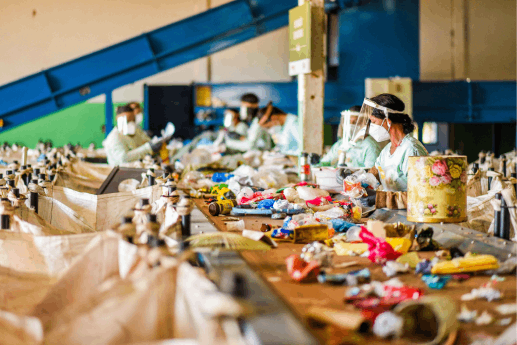The dawn of the plastic age was a milestone in human development driving our technological revolution, transforming industries, enabling innovation, saving lives as well as improving daily life.
It now threatens to be a millstone with runaway waste levels that are rising as our population increases and becomes more affluent. It is everywhere – in all industries, across food supply chains and sadly in our environment.
Australia’s abundant, unique and diverse natural habitats are particularly at risk, not least the Great Barrier Reef and Ningaloo – the national science agency CSIRO estimates 130,000 tonnes of plastic leaks into Australia’s marine environment each year while across Asia and the Pacific more than 11 billion pieces of plastic are clogging our reefs driving the risk of coral disease up from 4% to 89% in plastic-hit areas. Overall, 85% of Australia’s terrestrial plastic waste ends up in landfill, a statistic in line with global rates of recycling rates.
The problem is, on the current trajectory, plastic waste levels are set to double by 2050 and triple by 2060 unless we take effective action and develop a circular plastic economy.
Almost all plastics are made from fossil fuels, so increased recycling and reduced production of new plastics alongside efficiencies in use will make a major contribution to achieving net zero targets.
Given Australia’s unique ecosystem, it is not surprising that the country is taking action with government commitment to a circular economy, pledging to recycle all plastics by 2040. The CSIRO has developed a circular economy roadmap for plastics and other waste. It estimated just boosting recycling rate by 5% will create many more jobs and add USD 1 billion to Australia’s GDP.
The Missing Puzzle Piece: Expanding Private Investment Recognition
These are just a few examples among many initiatives at state and federal levels driven by policy and private enterprise, but they are baby steps. We need to accelerate efforts exponentially to avoid a plastic apocalypse.
It requires collective action through public-private-people partnerships and substantial capital investment. A burgeoning understanding of the issue has spurred numerous initiatives by governments, international organisations and concerned citizens but to get to a future where plastic circularity is a scalable reality, significant investment needs to step up along the entire value chain or we will fail.
McKinsey estimates achieving just 20 to 30% of recycled content in plastic packaging by 2030 needs $100 billion investment.
Investment opportunities in plastics have significant parallels with energy transition which is also driven by private-public sector partnerships and attracted $1.8 trillion in investments last year, up 17% from the previous year. Private investors, in collaboration with governments and multilateral organisations, are directing investments toward renewable energy and other innovative technologies. Major initiatives like the Just Energy Transition Program (JETP) are allocating up to $50 billion to reshape the energy mix in countries like Indonesia, South Africa, and Vietnam. The private sector today recognises the growing demand for renewable energy and related solutions, anticipating increased affordability as technologies advance and economies of scale take effect. We need to get the plastics opportunity similarly recognised.
We have started to see some of more forward-looking investors recognise the opportunity. Private investment is already a linchpin in many countries through the principle of Extended Producer Responsibility (EPR) – making plastics producers and sellers responsible for waste collection and recycling. In Australia, similar efforts under the Product Stewardship Act covers sectors like oil, electronics, and packaging, albeit to a lesser extent. When done right, EPR policies can support the development of a new industry infrastructure and create employment.
Opportunity for Engagement in Developed and Developing Economies
Developed countries, despite notable recycling processes, still struggle to lift recycling rates. In Australia only 15% of plastic packaging is reused, recycled or composted, falling far short of the 100% target set for next year. Managing waste in regional and remote areas presents many challenge, including limited or absent curbside waste collection services. The A$250 million Recycling Modernisation Fund aims to address these issues, yet government data suggests that meeting the 2025 National Packaging Targets is still unlikely.
Globally, many countries face difficulties in combatting plastic pollution, with over 60% of the 192 countries studied having underdeveloped or incipient waste systems. Clearer legal frameworks and policies are needed to catalyse capital participation from both public and private sectors. A big step in the right direction will be finalising the International Legally Binding Instrument on plastic pollution by the end of 2024. A well-structured global agreement on plastic pollution will help harmonise metrics and reporting requirements for plastic waste and can help mobilise capital via new financial mechanisms, accelerating the development and deployment of solutions that improve resource efficiency.
The Alliance to End Plastic Waste
The Alliance to End Plastic Waste is part of the solution bringing together more than 70 companies across the plastic value chain, local communities, civil society groups, intergovernmental organisations, and governments to build collaborative solutions, with a keen focus on matching capital with opportunities that deliver value and positive impact.
The Alliance is collaborating across the world with private enterprise, governments, and multilaterals to create awareness and attract investment in the US $120 billion opportunity to develop a long term, sustained plastic circular economy. We team up with universities, partner private equity managers such as Lombard Odier, and work alongside governments and development finance institutions to drive public-private partnerships.
While the business and environmental case is strong, plastic circularity as an investable theme is in the early stages of development. Education, reporting and policy efforts can further accelerate participation from capital providers. As a crucial pillar supporting the global sustainability transition, there is a clear opportunity for investors to consider and shape as they seek new factors for portfolio construction and growth.

